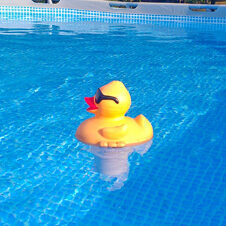If you’ve had your swimming pool for a few years it may be time to drain your pool water. Your pool water should be drained and replaced every five to seven years to maintain the quality and safety of the water. You may also need to drain your pool water if the pool needs repairs or if the water is exceptionally dirty. This process isn’t too complicated, but you’ll need a few tools and a few things to keep in mind before you get started.
When to Drain Your Pool Water
Pools aren’t meant to be drained regularly. Draining your pool water can pose risks to the integrity of your pool’s structure.
When the pressure of the water is no longer there, certain features such as your lights might be damaged, and the floor and walls of your pool are more likely to dry out and crack. For this reason, most people leave their pools full during winter and simply rebalance the chemicals in the new season. However, certain situations might require draining and replacing the water.
Routine Maintenance
Although it’s usually preferable to keep the water in your pool, experts suggest that you drain your pool water and replace it with new water every five to seven years.
Or when there are more than 2500 ppm total dissolved solids (TDS). This is because chemically balancing the water in your pool will become more difficult at this point, and you will need to use increasing amounts of chemicals, which isn’t healthy for you or the environment.
Excess Dirt or Grime
Normally, pools can be cleaned without removing all the water.
Large debris such as leaves or a buildup of algae can be scooped out with a rake. Smaller particles, which might have settled at the bottom of your pool or on the walls, can be cleared out with a pool vacuum.
Even if your pool looks very dirty, you can likely make it safe again by removing all the debris and rebalancing the chemicals.
However, if your pool has been sitting unused for a few years or if you see a significant build-up of dirt, algae, and grime that is hard to remove, it may be time to drain your pool water and start fresh. To reduce the risk to the pool you may be able to do a partial drainage, leaving some water in the pool, but in some cases, a full drain is going to be needed.
Pool Repairs
When you first install your pool, you might not do any maintenance for several years.
During this time, replacing the water shouldn’t be necessary. However, as your pool gets older, it might need some maintenance work. Concrete pools will need to be resurfaced once every ten years, and pools with a vinyl layer might need to have the liner replaced every six to twelve years.
We recommend speaking to a pool repair specialist before carrying out repairs because they can let you know how and when to drain your pool. They can also give you an estimated time frame for the repair to be completed, so you know when to have fresh clean water ready for delivery.
The Best Time of Year
Not every season is good to drain your pool water.
If you can help it, try not to complete this task during the cold and wet months. The pressure around the pool is greater at that time and can cause in-ground pools to crack.
Instead, pick a dry, clear week when there is little moisture in the ground. On the other hand, you don’t want to expose your floor and walls to extremely hot temperatures, so the hot summer months are best avoided.
Most pool experts agree that you should drain your pool water when the temperatures are below 82 degrees. In West Virginia and surrounding areas, this means that the spring and fall months are best. Aim to drain your pool in April, May, September, or October if possible, since it won’t be too cold or too hot.
How to Drain a Pool
If you’ve never drained your pool before, it’s worth consulting an expert, who can tell you how to best perform this task.
Before you drain the water, be sure to contact your local water authority to get the rules and regulations for water disposal. You’ll need a fully submersible pump, a standard garden hose, an adapter to connect your pump and hose, and hydrostatic plugs.
You may also need a hammer, screwdriver, and pliers for additional assistance. When you’re ready to drain your pool water, unplug the pool’s pump and any other electrical components connected to the pool.
Attach the garden hose to the pump and make sure you have enough to lead the water to the drainage point. Submerge the pump into the water and plug it into the pool’s GFCI outlet.
Depending on the size of your pool, it can take up to 14 hours for the water to completely drain. Be sure to check the progress periodically and don’t let the pump run dry.
Discharging the Water
One of the most important considerations is what you will do with the water.
Start by checking the chemical balance and making sure it is as neutral as possible since this will prevent the ground from becoming contaminated. Never pour the water into another water source, such as a river or a lake, since chlorine and other chemicals could cause contamination and damage to wildlife.
Additionally, take care not to simply pour the water out near your pool. Experts suggest discharging it at least 66–98ft away since you don’t want the pressure to build up and damage the structure of your pool. Discharging your water via the sewer drainage system could be a good idea. Again, it’s very important to contact your local water authority first to know where the water can be disposed of.
Alternatively, if you don’t want to drain your pool yourself, or if you are unsure of where to discard the water, you can hire a water draining service. A professional water draining company can pump the water out of your pool and discard the water ethically.
Contact Taylor Farm’s Water Hauling
Once you’ve completed any necessary repairs and cleaned your pool thoroughly, it’s time to fill it back up with water.
Having water delivered to your pool is a quick and easy way to fill up your pool. Taylor Farm’s Water Hauling provides clean, chlorinated pool water directly to you, meaning you could be swimming again within 24 hours.
You shouldn’t need to drain your pool water frequently.
This is typically recommended if there is an excessive amount of dirt, your water has been in the pool for more than five to seven years, or you need to carry out major repairs.
If you’re searching for clean, locally sourced water for your swimming pool, large event, construction site, or emergency service your search is over!
Taylor Farm’s Water Hauling is the area’s leader in water delivery for West Virginia, Maryland, Virginia and limited areas of Pennsylvania. You may contact us online or call us at 304.229.1194. We deliver water for any size swimming pool or hot tub, ponds, and cisterns. We also provide potable water for events and emergency services.




